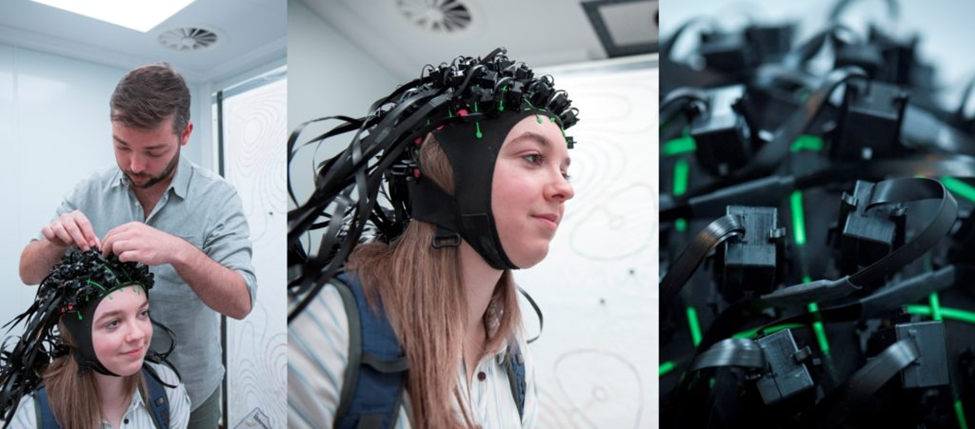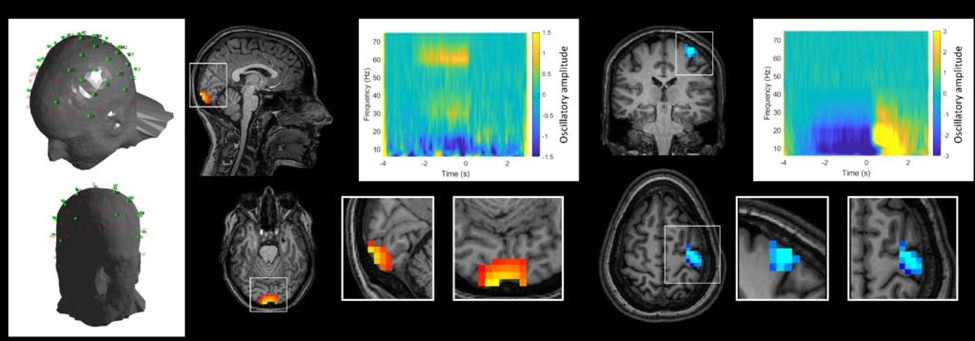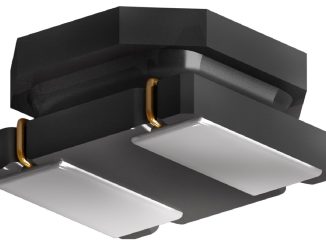
QuSpin, a manufacturer of highly sensitive magnetometers that are gaining popularity among neuroscientists, reports that it has developed a three-axis variant that will bring new sensing capabilities to magnetoencephalography measurements. Meanwhile, researchers at the University of Nottingham have used the company’s two-axis sensors to operate a whopping 50-channel array, shown above.
“Our current Gen-2 QZFM can sense y and z components of the magnetic field but not x. Because many applications can greatly benefit from a sensor that can detect all three components, we have developed a new triaxial variant,” reported Vishal Shah, QuSpin founder and chief scientist, in March.

The triaxial variant has the same size, weight, power and cost as the standard variant. Its sensitivity is slightly lower but it can be ideal for use as a reference sensor for MEG, for magnetocardiography other applications. Deliveries are expected to begin in the May-June timeframe, said Shah.
QuSpin describes its optical magnetometers as the first non-cryogenic alternative to superconducting magnetometers that are extremely sensitive, easy to use and very flexible and can take extreme field sensing from the lab to the real world.

The company’s Gen-2 Zero-Field Magnetometer (QZFM), shown above, is an ultra-sensitive vector magnetometer that operates in low field environments. It is among the most sensitive magnetic detectors with performance rivaling superconducting technologies, says QuSpin. The sensor head operates at room temperature and fully integrates the laser with other components, eliminating the complexities of fiber optics or cryogenics. Each QZFM is self-calibrating and can simultaneously measure field components along two axes. The compact electronics module with a dedicated microprocessor provides all necessary functionality to simply operate the sensor with a few clicks of the mouse.

QuSpin also makes a compact, high-sensitivity Total-Field Magnetometer (QTFM) which can operate in Earth’s field and can resolve minute field changes for applications such as magnetic observatories and aboard small, mobile platforms.

At the University of Nottingham, the Sir Peter Mansfield Imaging Centre has configured what it says is the first 50 channel OPM-MEG array in operation based upon QuSpin sensors. The system uses Gen-2 QZFM mounted on the scalp using a flexible cap, to measure the magnetic fields generated by current flow through neuronal assemblies. In this way it offers direct and non-invasive inference on human brain electrophysiology.
The system is housed within a dedicated magnetically shielded room built by Magnetic Shields Ltd which reduces environmental magnetic interference and limits static field. Background fields are further controlled by a set of bi-planar coils also now available commercially from MSL, said the center. This precise field control, coupled with the lightweight scalp mounted sensors and cap, uniquely enables MEG measurement even if a subject moves during the measurement.
The images at the top of this article show a first demonstration of the 50-channel device which employed a visuo-motor task. The subject was shown a visual stimulus comprising a pattern of drifting concentric circles known as a circular grating. While the visual stimulus was on the screen, the subject was asked to move their finger for a hundred 7-second trials. Following OPM-MEG data collection, the locations and orientations of the sensors on the scalp were measured using a newly developed optical scanning technique. Accurate knowledge of OPM placement allowed data modelling using a beamformer to determine precisely where in the brain any measurable neuromagnetic effects originate.

The image above shows the results. The left-hand panel shows the locations of the OPMs on the scalp as determined by optical scanning. The center and right panels show measured brain function in the visual, and motor cortices respectively.
The experiments represent a significant step towards the development of a whole head OPM-MEG device. With increased flexibility to adapt to any head shape, movement tolerance to enable novel experimental paradigms, and extremely high-quality data, this offers a step change in neuroscientific experimentation, said the researchers.
Based in Louisville, Colorado, QuSpin was started in 2012 with research funding from the National Institutes of Health. Its multidisciplinary team of physicists and engineers have worked on development projects with the US Navy for a tri-axial vector atomic magnetometer and a low-cost scalar atomic magnetometer. In 2018, the company reached a milestone of having shipped more than 500 of its QZFM magnetometers.
For more info, see www.quspin.com and www.nottingham.ac.uk



